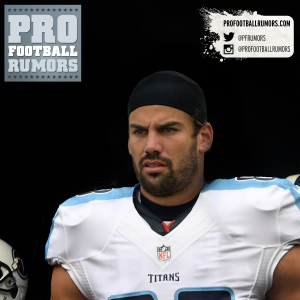Even though the Titans extended their playoff drought to eight years in 2016, the team made noticeable progress for the first time in a while. The Titans matched the Texans at 9-7, only finishing behind the AFC South champions because of a tiebreaker, and ranked a division-best 13th in the NFL in Football Outsiders’ DVOA metric. After his club nearly broke through last year, Titans general manager Jon Robinson spent the offseason making meaningful upgrades on both sides of the ball.
Notable signings:
- Logan Ryan, CB: Three years, $30MM. $12MM guaranteed.
- Sylvester Williams, DT: Three years, $16.5MM. $7.25MM guaranteed.
- Jonathan Cyprien, S: Four years, $25MM. $7MM guaranteed.
- Brynden Trawick, S: Two years, $4.75MM. $3MM guaranteed.
- Eric Decker, WR: One year, $4MM. $2.5MM guaranteed. $1.5MM available via incentives.
- Daren Bates, LB: Three years, $6MM. $1MM guaranteed.
- Karl Klug, DL: Two years, $5MM. $1MM guaranteed. $800K available via incentives.
- Phillip Supernaw, TE: Two years, $3MM. $600K guaranteed.
- Matt Cassel, QB: Two years, $5.25MM. $500K guaranteed.
- Nate Palmer, LB: Two years, $2.3MM. $350K guaranteed.
- Eric Weems, WR: Two years, $2.6MM. $275K guaranteed.
- Tim Lelito, OL: One year, $1MM. $100K guaranteed.
- Demontre Hurst, S: One year, $690K.
Robinson’s most recent splash came last month with the signing of wide receiver Eric Decker, who unexpectedly fell into the Titans’ laps after the rebuilding Jets released him. A shoulder injury limited Decker to three games last season and kept him out of the Jets’ lineup for the final three months of the campaign, but there’s no indication that it’ll hamper him going forward. That means a Tennessee offense which finished 2016 atop the league in red zone touchdown percentage should continue to be a force inside the opposition’s 20-yard line.
The 6-foot-3, 206-pound Decker has been a major threat near the goal line throughout his career, and he’s second only to ex-Jets teammate Brandon Marshall in red zone TD receptions since 2012 (33). The 30-year-old figures to mesh beautifully with Titans quarterback Marcus Mariota, who dominated in the red zone with 18 TD passes and no interceptions during his initial two years in the league.
When he signed with the Titans, Decker became the fourth potentially significant passing game weapon Robinson picked up for Mariota this offseason. The executive struck three times in the draft, using high selections on two wideouts – first-rounder Corey Davis and third-rounder Taywan Taylor – and another on tight end Jonnu Smith (Round 3). Of course, the headliner is Davis, who went fifth overall after surpassing 1,400 yards and 12 touchdowns in each of the past three seasons at Western Michigan. Interestingly, Lance Zierlein of NFL.com likens Davis to Decker, calling the 6-2, 205-pound rookie a “touchdown juggernaut.”
With Decker, Davis, Rishard Matthews and Taylor serving as the top four in their receiving corps and Smith joining the prolific Delanie Walker at tight end, Mariota has an enviable supply of aerial options on hand. Plus, the dual-threat signal-caller should again be a key contributor to a top-tier rushing attack. DeMarco Murray, Derrick Henry and Mariota ran behind arguably the NFL’s best offensive line and led a ground game that finished third in the league in rushing and fourth in yards per carry in 2016. Murray and Henry remain in the fold, as does the Titans’ starting O-line from last year, which is an unfortunate reality for opposing defenses.
Speaking of defenses, the Titans’ Dick LeBeau-coordinated unit entered the winter in need of a makeover after ranking 20th in the league in yardage and 24th in DVOA. Robinson came through at the outset of free agency, reeling in two proven starters for his secondary in Jonathan Cyprien and Logan Ryan.
Cyprien spent the first four years of his career as a member of the division-rival Jaguars, with whom he started in all 60 appearances. He ranked as Pro Football Focus’ seventh-best safety last year, when he earned a near-flawless grade as a run defender.
Ryan, on the other hand, is a far bigger asset against the pass, and he’s coming off an excellent four-year showing in New England. As the Patriots’ former scouting director, Robinson was in their front office when they chose Ryan in the third round of the 2013 draft. Ryan, 26, is now a two-time Super Bowl champion who contributed heavily to New England’s defense with a combination of durability (64 straight appearances, including 40 starts) and productivity (13 interceptions).
Ryan and the Titans’ second first-rounder, 18th overall pick Adoree’ Jackson, are in line to helm a remade corner corps that also includes veteran Brice McCain, who started 10 games last year and rated as PFF’s 33rd-best CB. Jackson, like Ryan, is a ball hawk, having closed his USC career with five picks last season. Those two and McCain make for an impressive trio on paper, though it’s questionable whether the Titans have enough behind them. The pro track records of their other corners – Leshaun Sims, Kalan Reed, D’Joun Smith and Bennett Okotcha – range from nonexistent to extremely limited.
Considering Tennessee’s defense ended last year 26th in DVOA against the pass and 10th versus the run, it’s no surprise Robinson devoted most of his attention earlier this offseason to the secondary. But he didn’t ignore his team’s defensive line, where he signed nose tackle Sylvester Williams and re-upped role player Karl Klug early in free agency.
Despite starting 48 of 60 appearances in Denver 2013-16, Williams didn’t really live up to his first-round status in the Mile High City. With 5.5 career sacks, he won’t do a lot to aid the Titans’ pass rush (granted, after tallying the league’s fifth-most sacks and 12th-most hurries in 2016, it didn’t really need any), and it’s up for debate how much the 313-pounder will boost their run ‘D’. PFF assigned Williams a rather abysmal grade in that department last year, when 337 of his 644 snaps came in run situations. The outlet was much more bullish on Klug, whom it rated 22nd among 127 qualified interior defensive linemen (Williams was 46th). Klug has been valuable as defensive depth and on special teams since the Titans used a fifth-round pick on him in 2011, so it was likely a no-brainer for Robinson to bring him back for a meager $1MM in guaranteed money.
Notable losses:
- Antonio Andrews, RB
- David Bass, LB
- Byron Bell, OL
- Valentino Blake, CB
- Anthony Fasano, TE
- Rashad Johnson, S
- Marc Mariani, WR
- Jason McCourty, CB: Released
- Brian Schwenke, OL
- Sean Spence, LB
- Daimion Stafford, S
- Chance Warmack, G
- Al Woods, DT: Released
- Kendall Wright, WR
The Titans secured some potential high-impact players during free agency and the draft. At the same time, they didn’t say goodbye to any indispensable cogs. Jason McCourty stands out as the best of their departures. Prior to his release in April, the corner was the Titans’ longest-tenured player. McCourty had been with the team since it stole him in the sixth round of the 2009 draft, and he went on to start 90 games and pick off 13 passes in Tennessee. He accumulated 14 of those starts and two INTs last year, though PFF only regarded him as a middle-of-the-pack corner. The Titans, meanwhile, viewed him as too pricey. McCourty, now with the Browns, can still play, but he’s an obvious step down from Ryan at this juncture.
Unlike McCourty, others who exited the Titans’ roster in recent months didn’t come close to leaving indelible marks on the franchise. However, Sean Spence, Al Woods, Daimion Stafford, Rashad Johnson and Anthony Fasano did have semi-prominent roles with the club last year. The addition of Cyprien made Stafford and Johnson expendable, though, and the Titans immediately signed Williams to replace the released Woods. Meanwhile, Tennessee’s hope is that the blocking skills of Jonnu Smith and its offensive line will cover for Fasano’s exit.
Replacing Spence, who played half the Titans’ defensive snaps last year, could be a more difficult task. Now with the Colts, Spence was one of the most efficient tacklers in the league in 2016, according to PFF’s Michael Manning, who noted in May that the defender was also quite productive as a pass rusher. The Titans, to their credit, have a quality starting inside linebacker tandem with Avery Williamson and Wesley Woodyard. But going from Spence to the re-signed Nate Palmer as the top reserve in the middle looks like a downgrade.
Trades:
- Acquired a 2017 third-round pick (No. 72; WR Taywan Taylor) and a 2017 sixth-round pick (No. 200) from the Patriots in exchange for a 2017 third-round pick (No. 83; DE Derek Rivers) and a 2017 fourth-round pick (No. 124).
- Acquired a 2017 sixth-round pick (No. 207) and a 2017 seventh-round pick (No. 241; RB Khalfani Muhammad) from the Giants in exchange for a 2017 sixth-round pick (No. 200; T Adam Bisnowaty).
- Acquired a 2017 sixth-round pick (No. 217; OL Corey Levin) and a 2017 seventh-round pick (No. 227; LB Josh Carraway) from the Bengals in exchange for a 2017 sixth-round pick (No. 207; S Brandon Wilson).
Draft picks:
- 1-5: Corey Davis, WR (Western Michigan)
- 1-18: Adoree’ Jackson, CB (USC)
- 3-72: Taywan Taylor, WR (Western Kentucky)
- 3-100: Jonnu Smith, TE (FIU)
- 5-155: Jayon Brown, LB (UCLA)
- 6-217: Corey Levin, OL (Chattanooga)
- 7-227: Josh Carraway, LB (TCU)
- 7-236: Brad Seaton, T (Villanova)
- 7-241: Khalfani Muhammad, RB (California)
Extensions and restructures:
- Wesley Woodyard, LB: Extended through 2019. Three years, $10.5MM. $2MM guaranteed.
- Harry Douglas, WR: Accepted pay cut. Reduced 2017 base salary of $3.75MM to $1.75MM. $1.75MM available via incentives.
- Da’Norris Searcy, S: Accepted pay cut. Reduced 2017 base salary of $5.625MM to $3.4MM, and 2018 base salary of $6.125MM to $2.8MM. $750K available via annual incentives.
A former Bronco, Woodyard joined the Titans after the 2013 season and did enough over his first three years with the organization to earn a reasonably priced extension. The 31-year-old Woodyard, who’s now under Tennessee’s control through 2019, has appeared in 48 games in a row as a Titan. Thirty-eight of those contests have been starts, including 10 last season, when Woodyard graded as PFF’s 29th-best linebacker. Overall, Woodyard has collected 10 sacks and three INTs in Tennessee.
Other:
- Exercised 2018 fifth-year option for T Taylor Lewan ($9.341MM).
- Signed 12 undrafted rookie free agents.
Picking up Lewan’s fifth-year option was an easy call for Robinson, who was one of the premier acquisitions of previous GM Ruston Webster’s tenure. Lewan, whom Webster took 11th overall in 2014, is coming off his first 16-start season, in which the left tackle earned a Pro Bowl nod. He’ll be a Titan through at least 2018, meaning they’ll have the elite-caliber offensive tackle duo of Lewan and Jack Conklin for a minimum of two more seasons.
Top 10 cap charges for 2017:
- Brian Orakpo, LB: $9,450,000
- Logan Ryan, CB: $8,666,666
- Jurrell Casey, DT: $8,588,750
- Derrick Morgan, LB: $7,968,750
- DeMarco Murray, RB: $6,950,000
- Marcus Mariota, QB: $6,603,811
- Rishard Matthews, WR: $6,333,333
- Delanie Walker, TE: $5,317,708
- Jonathan Cyprien, S: $4,750,000
- Sylvester Williams, DT: $4,666,666
Robinson has done laudable work during his two offseasons as Tennessee’s GM, and the moves he made this past winter and spring just might propel the team back to the playoffs. It appears the Mike Mularkey-coached Titans will enter the season with the strongest roster in a division that’s there for the taking.
Information from Over the Cap and Roster Resource was used in the creation of this post. Photos courtesy of USA Today Sports Images.



